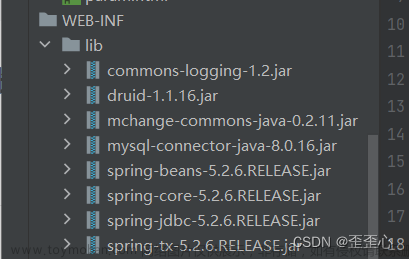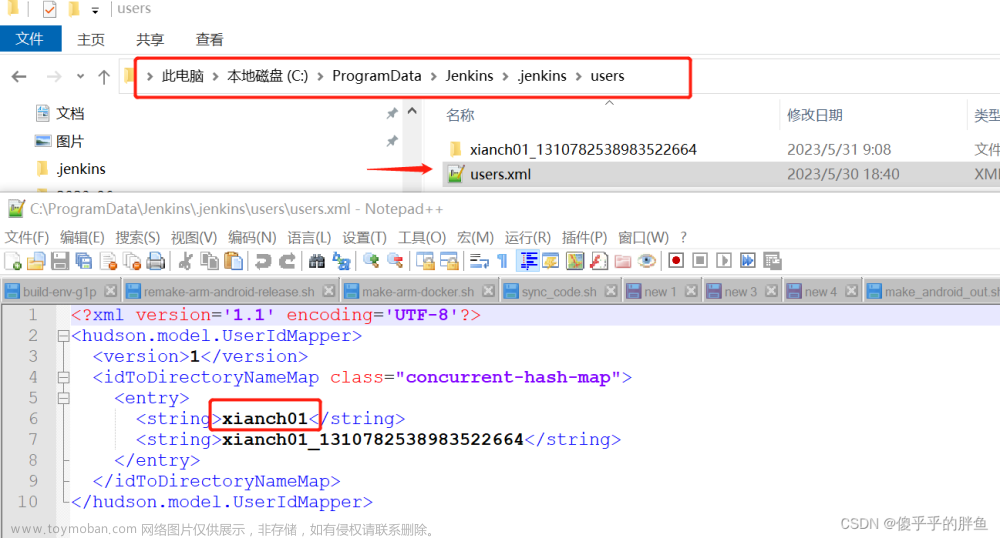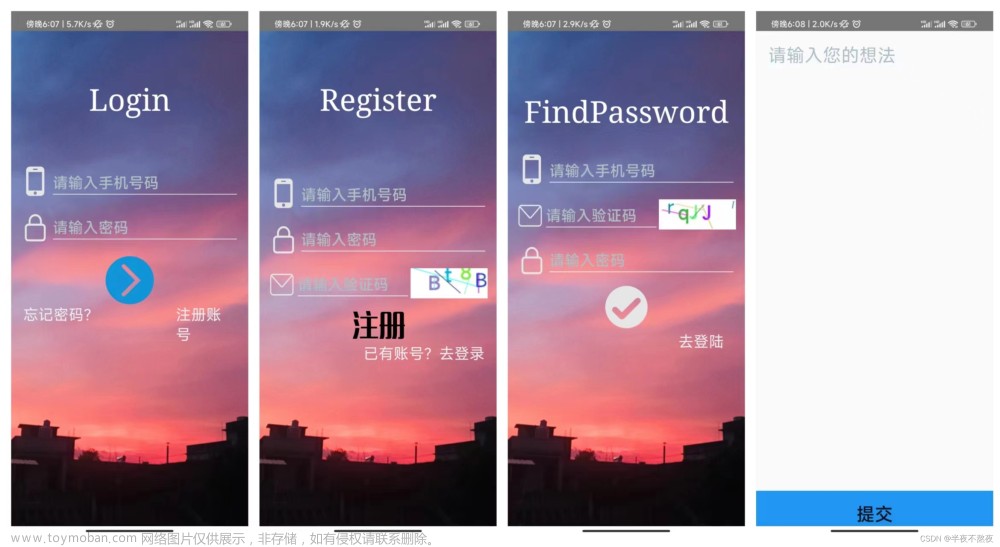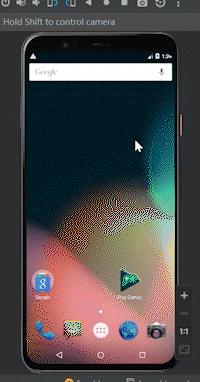一 问题描述:
制作一个简单的登录界面,并使用文件储存方式储存用户名和密码,在下次打开应用时自动获取上次储存的账户和密码
二 解题思路:
文件储存:
文件存储是Android中最基本的一种数据存储方式,其与java中的文件存储类似,都是通过I/O流的形式把数据直接存储到文件中。
内部存储使用的是Context提法的openFileOutput()方法和openFileInput()方法,这两个方法能够返回进行读写操作的FileOutputStream和FileInputStream对象。
openFileOutput():用于打开应用程序中对应的输出流,将数据存储到指定的文件中
openFileInput():用于打开应用程序对应的输入流,读取指定文件的数据
操作模式:
MODE_PRIVATE:该文件只能被当前程序读写
MODE_APPEND:该文件的内容可以追加
MODE_WORLD_READABLE:该文件的内容可以被其他程序读
MODE_WORLD_WRITEABLE:该文件的内容可以被其他程序写
Android默认任何应用创建的文件都是私有的,其他程序无法访问。但是一旦拥有权限其他用户就可以查看用户的私有目录,所以这种村存储账号密码的方式也不是很安全。在真正的应用上是一定要经过加密的。
布局线框图:

三 登录界面代码:
布局代码:
使用一个ImageView控件来显示用户的头像,TextView和EditView来组合成输入界面,Button按钮实现登录按钮。
activity_main.xml
<?xml version="1.0" encoding="utf-8"?>
<LinearLayout xmlns:android="http://schemas.android.com/apk/res/android"
xmlns:app="http://schemas.android.com/apk/res-auto"
xmlns:tools="http://schemas.android.com/tools"
android:layout_width="match_parent"
android:layout_height="match_parent"
android:background="#E6E6E6"
android:orientation="vertical"
android:padding="10dp"
tools:context=".MainActivity">
<ImageView
android:layout_width="70dp"
android:layout_height="70dp"
android:layout_centerHorizontal="true"
android:layout_gravity="center_horizontal"
android:layout_marginTop="30dp"
android:src="@drawable/head" />
<LinearLayout
android:layout_width="match_parent"
android:layout_height="wrap_content"
android:layout_marginTop="15dp"
android:background="@android:color/white"
android:orientation="horizontal">
<TextView
android:layout_width="wrap_content"
android:layout_height="wrap_content"
android:padding="10dp"
android:text="账号:"
android:textColor="#000"
android:textSize="20sp"/>
<EditText
android:id="@+id/et_account"
android:layout_width="match_parent"
android:layout_height="wrap_content"
android:layout_marginLeft="5dp"
android:background="@null"
android:padding="10dp"/>
</LinearLayout>
<LinearLayout
android:layout_width="match_parent"
android:layout_height="wrap_content"
android:layout_marginTop="10dp"
android:background="@android:color/white"
android:orientation="horizontal">
<TextView
android:id="@+id/tv_password"
android:layout_width="wrap_content"
android:layout_height="wrap_content"
android:padding="10dp"
android:text="密码:"
android:textColor="#000"
android:textSize="20sp"/>
<EditText
android:id="@+id/et_password"
android:layout_width="match_parent"
android:layout_height="wrap_content"
android:layout_marginLeft="5dp"
android:background="@null"
android:inputType="textPassword"
android:padding="10dp"/>
</LinearLayout>
<Button
android:id="@+id/btn_login"
android:layout_width="match_parent"
android:layout_height="wrap_content"
android:layout_marginTop="25dp"
android:background="#3C8DC4"
android:text="登录"
android:textColor="@android:color/white"
android:textSize="20sp"/>
</LinearLayout>创建工具类:
在程序包中创建一个工具类FileLoginInterface(我这里命名不太合理,命名的时候建议使用FileSave类似的比较直观)
FileLoginInterface.java
package com.example.logininterface;
import android.content.Context;
import java.io.FileInputStream;
import java.io.FileOutputStream;
import java.io.IOException;
import java.util.HashMap;
import java.util.Map;
public class FileLoginInterface {
//保存密码和账号到data.txt文件中
public static boolean saveUserInfo(Context context, String account, String password){
FileOutputStream fos = null;
try{
//获取文件输出流对象fos
fos = context.openFileOutput("data.txt",Context.MODE_PRIVATE);
fos.write((account + ":" + password).getBytes());
return true;
}catch (Exception e){
e.printStackTrace();
return false;
}finally {
try {
if (fos != null){
fos.close();
}
}catch (IOException e){
e.printStackTrace();
}
}
}
//从文件中获取储存的账号和密码
public static Map<String, String> getUserInfor(Context context){
String content = "";
FileInputStream fis = null;
try{
//获取文件的输入流对象
fis = context.openFileInput("data.txt");
//将数据流对象中的数据转换为字节码的形式
byte[] buffer = new byte[fis.available()];
fis.read(buffer);//通过read()方法读取字节码中的数据
content = new String(buffer);//将获取的字节码转换为字符串
Map<String, String> userMap =new HashMap<String, String>();
//将数字以":"分割后形成一个数组的形式
String[] infos = content.split(":");
//将数组中的第一个数据放入userMap集合中
userMap.put("account",infos[0]);
//将数组中的第二个数据放入userMap集合中
userMap.put("password",infos[1]);
return userMap;
}catch (Exception e){
e.printStackTrace();
return null;
}finally {
try {
if(fis != null){
fis.close();
}
}catch (IOException e){
e.printStackTrace();
}
}
}
}
四 界面交互代码:
MainActivity.java
package com.example.logininterface;
import androidx.appcompat.app.AppCompatActivity;
import android.os.Bundle;
import android.text.TextUtils;
import android.view.View;
import android.widget.Button;
import android.widget.EditText;
import android.widget.Toast;
import java.util.Map;
public class MainActivity extends AppCompatActivity implements View.OnClickListener{
private EditText et_account; //账号输入框
private EditText et_password;//密码输入框
private Button btn_login;
@Override
protected void onCreate(Bundle savedInstanceState) {
super.onCreate(savedInstanceState);
setContentView(R.layout.activity_main);
initView();
//通过工具类FileLoginInterface中的getUserInfor()方法获取账号和密码信息
Map<String, String> userInfor = FileLoginInterface.getUserInfor(this);
if(userInfor != null){
//将获取的账号显示到界面上
et_account.setText(userInfor.get("account"));
//将获取的密码显示到界面上
et_password.setText(userInfor.get("password"));
}
}
private void initView(){
et_account = (EditText) findViewById(R.id.et_account);
et_password = (EditText) findViewById(R.id.et_password);
btn_login = (Button) findViewById((R.id.btn_login));
//设置按钮的监听事件
btn_login.setOnClickListener(this);
}
@Override
public void onClick(View v){
switch (v.getId()){
case R.id.btn_login:
//当点击登录按钮时,获取界面上的账号和密码
String account = et_account.getText().toString().trim();
String password = et_password.getText().toString();
//检验输入的账号和密码是否为空
if(TextUtils.isEmpty(account)){
Toast.makeText(this,"请输入账号",Toast.LENGTH_SHORT).show();
return;
}
if(TextUtils.isEmpty(password)){
Toast.makeText(this,"请输入密码",Toast.LENGTH_SHORT).show();
return;
}
Toast.makeText(this,"登录成功",Toast.LENGTH_SHORT).show();
//保存用户信息
boolean isSaveSuccess = FileLoginInterface.saveUserInfo(this,account,password);
if(isSaveSuccess){
Toast.makeText(this,"保存成功",Toast.LENGTH_SHORT).show();
}else{
Toast.makeText(this,"保存失败",Toast.LENGTH_SHORT).show();
}
break;
}
}
}
运行效果:
第一次运行:

输入账号和密码,点击登录

停止运行并再次运行:文章来源:https://www.toymoban.com/news/detail-424763.html
 文章来源地址https://www.toymoban.com/news/detail-424763.html
文章来源地址https://www.toymoban.com/news/detail-424763.html
到了这里,关于Android简单登录界面,保存账号和密码(基础,详解)的文章就介绍完了。如果您还想了解更多内容,请在右上角搜索TOY模板网以前的文章或继续浏览下面的相关文章,希望大家以后多多支持TOY模板网!












